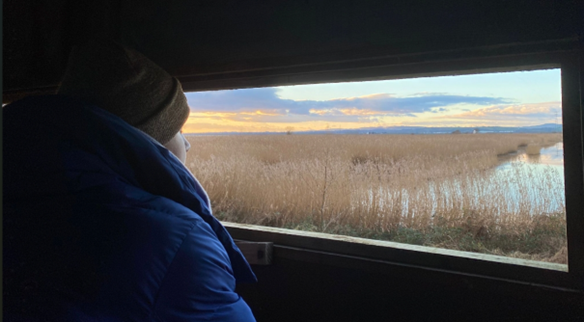Becoming a birdwatcher sneaks up on you slowly and then all at once.
Learning, listening and seeing birds in different places across the UK has greatly improved my mental health and wellbeing in ways I didn’t expect.
In this blog, I’ll share some of my reflections on becoming a birder after turning thirty and a few simple ways you can start taking notice of the amazing birds outside your window.
Birdy, thirty and thriving
I’ve always loved animals and being amongst nature.
I was the kid who watched all the animal documentaries, constantly pleaded with my parents for a dog and would watch transfixed as Steve Irwin waded into a river in Australia to greet a crocodile by pulling its tail.
Over the years, I’ve been so fortunate to see some amazing wildlife around the globe, but it took me entering my fourth decade to realise that there’s also a whole world of wonderful wildlife much closer to home.
It started with buying a bag of seed to tempt some feathered friends to our new garden when we moved into our house, following many years in a one bed flat with no outside space.
After a few weeks of no visitors, one day a medium sized bird with dark, glossy wings landed on the feeder making a heck of a racket. It was a starling.
As we watched, suddenly a flock of them descended and I’d never seen so many birds on a feeder before. The starling gang were jostling over the seeds, shimmering in the winter sunlight, and making their presence heard as they squawked through long, pointy beaks: the birds had truly arrived, and they were here to stay.
Taking the time to stop and see
After this encounter, I started to pay attention to birds in a way I hadn’t before. As more avian visitors slowly started to fly into our garden, I’d stand staring at them out of the window, trying desperately to identify what bird it was and if I’d seen it in the garden before.
For that small pocket of time peering outside, my mind was completely transfixed on the nature happening right outside my window. After watching the birds for just a few minutes, I found myself feeling more relaxed, tension in my shoulders released and I started breathing a little easier.
For just a moment, seeing the birds gave me the opportunity to see myself a little clearer. It was a nice feeling.
The birds I was seeing then included what I now know as house sparrows, blackbirds, robins, goldfinches, blue tits, great tits and chaffinches and a whole new feathered world was opened to me: I could find a mindful moment every day that physically and mentally made me feel better just by stopping and noticing the birds.
Reaching a birthday milestone can help put things in perspective sometimes. This was certainly the case for me – I had found a new hobby (meaning here the activity and not the bird of prey; sorry, bird nerd joke). I am well and truly a birder for life now.
Tips to start your birdwatching journey
I can talk about birds, the joy of birdwatching and the positive impact it has had on my mental wellbeing all day long. I recommend it to anyone looking to learn something new and feel more connected to the nature around them.
It can feel a bit daunting to starting a new hobby, but birdwatching is something everyone can access and enjoy, if you take the time to stop, look and listen.
Here are a few simple tips to help you give birding a try:
1. Try and notice nature around you every day
Can you see a bird outside your window? What birdsong can you hear right now? How many birds did you count on your commute this morning?
Taking a moment to stop, breathe, look and listen to the nature around you can really help improve your wellbeing.
It can be easier said than done sometimes in a world where we are constantly on the go but if you can find a few minutes in your day to pause and look at the wildlife around you, even if only for a moment, I am confident that it will help you feel more balanced and relaxed.
It may even lead to you becoming a fully-fledged birder!
2. Start a bird list
A notebook and pen or the notes app in your phone is a great place to start when first trying to identify birds.
Familiarise yourself with two or three species of birds to begin with (robin, blackbird and blue tit are some of our most well-known and easily identified garden birds) and make a note of how often you see them.
You’ll be surprised how quickly you build up sightings and the speed in which you can identify birds you know well. Knowing more about birds means you’ll naturally tune into seeing them more easily, building your knowledge and interest one bird at a time.
If you’re committed to a regular list (and who doesn’t love a list?) the British Trust of Ornithology (BTO) ask for weekly submissions of the birds people see in their garden so they can better understand patterns in bird behaviour and species numbers.
Learn more about the weekly BTO Garden Birdwatch and take your bird list writing to a whole new level.
3. Using your ears, eyes and tech
More often than not, you’re likely to hear a bird before you see it. Getting to know what different birdsong sounds like will help when it comes to locating the bird and getting a closer look.
There’s also so much variety in birdsong when you stop and notice – I’m a big fan of the small but mighty Wren who certainly makes a big noise for such a tiny bird.
Binoculars are also a great tool to have in your birding kit so you can see details like beak shape, leg colour and feather pattern to help you identify the species.
One of the most helpful free tools I’ve found when birding is the Merlin Bird ID by Cornell Lab app. The app is free to download and works around the world. When you hear a bird, open the app and record the sound you’re hearing. It’ll tell you who’s making the sound and include ID photos, song clips and information about the species you’ve just heard and hopefully seen.
It has been an invaluable tool when learning more about birds and a great starting point for anyone wanting to improve their ear for birdsong. Available to download on Apple and Google Play.
4. Visit your local bird and wildlife reserve
We are lucky to have such a wide variety of birds and amazing nature reserves on offer in the UK.
Charity organisations like the Royal Society for the Protection of Birds (RSPB) and the Wildfowl and Wetlands Trusts (WWT) have established many reserves across the country where you can view birds and enjoy a great day out for the whole family.
Most reserves have viewing hides, binoculars to loan, information events to attend and lovely cafes so you can enjoy a cake and a cuppa while birdwatching. Find the nearest RSPB reserve and WWT site near you.
5. Take part in the Big Garden Birdwatch
There’s no better time to start learning about birds than the start of a new calendar year.
The RPSB’s Big Garden Birdwatch, the world’s largest garden wildlife survey, is a great way to dip your toe into the world of birding. Every January, hundreds of thousands of nature lovers take part, helping to build a picture of how garden birds are faring.
Between Friday 24 and Sunday 26 January 2025, spend an hour watching the birds in your patch and record the birds that land. Sign up for free today and get a helpful information pack to get you started.
Whether it’s visiting your local reserve, popping seed in a feeder in your garden, signing up to charity birdwatch or simply starting to pay attention to the wildlife around you, small actions everyday can help local wildlife and at the same time support your own wellbeing and mental health.
For me, good mental health and birdwatching are now intrinsically linked – they truly are birds of a feather. Happy birding!
Resources
- Merlin Bird ID by Cornell Lab app
- Take part in the RSPB Big Garden Birdwatch
- Vist an RSPB reserve and WWT site
- Start your weekly bird sighting list for the BTO Garden Birdwatch
Read more
- Canopi blog: How art and photography helped me on the road to recovery
- Canopi blog: Five ways to support your mental health and wellbeing through a healthy diet
- Canopi blog: Reading as therapy
See our list of recommended wellbeing resources.

